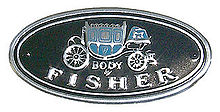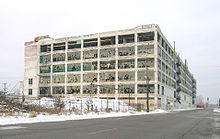Fisher Body - Picture

|
|
Fisher Body
Fisher Body is an automobile coachbuilder founded by the Fisher brothers in 1908 in Detroit, Michigan, which is now an operating division of General Motors Company. The name was well known to the public, as General Motors vehicles displayed a "Body by Fisher" emblem on their door sill plates until the mid-1980s.

Picture - 1960s logo
Fisher Brothers
Fisher Body's beginnings trace back to a horse-drawn carriage shop in Norwalk, Ohio, in the late 1800s. Lawrence P. Fisher (December 14, 1852 in Peru, Ohio - March 21, 1921, Norwalk, Ohio) and his wife Margaret Theisen (January 8, 1857 in Baden, Germany - October 13, 1936 in Detroit, Michigan) had a large family of eleven children; seven were sons who would become part of the Fisher Body Company in Detroit. Lawrence and Margaret were married in Sandusky, Ohio, on May 11, 1876.
The Fisher brothers were:
Early history
In 1904 and 1905, the two eldest brothers, Fred and Charles, came to Detroit where their uncle Albert Fisher had established Standard Wagon Works during the latter part of the 1880s. The brothers found work at the C. R. Wilson Company, a manufacturer of horse-drawn carriage bodies who were beginning to make bodies for the automobile manufacturers. With financing from their uncle, on July 22, 1908 Fred and Charles Fisher established the Fisher Body Company. However, their uncle soon wanted out and the brothers obtained the needed funds from Detroit businessman Louis Mendelssohn who became a shareholder and director. Within a short period of time, Charles and Fred Fisher brought their five younger brothers into the business.
Prior to forming the company, Fred Fisher had built the body of the Cadillac Osceola at the C. R. Wilson Company. Starting in 1910, Fisher became the supplier of all closed bodies for Cadillac, and also built for Buick.
In the early years of the company, the Fisher Brothers had to develop new body designs because the "horseless carriage" bodies did not have the strength to withstand the vibrations of the new motorcars. By 1913, the Fisher Body Company had the capacity to produce 100,000 cars per year and customers included: Ford, Krit, Chalmers, Cadillac, and Studebaker. Highly successful, they expanded into Canada, setting up a plant in Walkerville, Ontario, and by 1914 their operations had grown to become the world's largest manufacturer of auto bodies. Part of the reason for their success was the development of interchangeable wooden body parts that did not have to be hand-fitted, as was the case in the construction of carriages. This required the design of new precision woodworking tools.
Fisher Body Corporation and General Motors

Picture - Fisher Body Plant 21, Piquette and St. Antoine.
In 1916, the company became the Fisher Body Corporation. Its capacity was 370,000 bodies per year and its customers included Abbot, Buick, Cadillac, Chalmers, Chandler, Chevrolet, Churchfield, Elmore, EMF, Ford, Herreshoff, Hudson, Krit, Oldsmobile, Packard, Regal, and Studebaker.
The company constructed their signature factory, the Albert Kahn-designed Fisher Body 21, on Piquette Street, in Detroit, in 1919. The building is now part of the Piquette Avenue Industrial Historic District. At the time, the company had more than 40 buildings encompassing 3,700,000 square feet (344,000 m²) of floor space.
In a 1919 deal put together by president William C. Durant, General Motors bought 60% of the company. The Fisher company purchased Fleetwood Metal Body in 1925, and in 1926 was integrated entirely as an in-house coachbuilding division of General Motors. Fisher Body as a unique entity was dissolved by being merged with other GM operations in 1984.
Extent of operations
From its beginning in the "horseless carriage shop" in Norwalk, Ohio, to its sale in 1919 and 1926 to General Motors, the Fisher Body Company was built by the Fisher brothers into one of the world's largest manufacturing companies.
The company owned 160,000 acres (650 km) of timberland and used more wood, carpet, tacks, and thread than any other manufacturer in the world. It had more than 40 plants and employed more than 100,000 people, and pioneered many improvements in tooling and automobile design including closed all-weather bodies.
Fisher Body's contribution to the war effort in both World War I and World War II included the production of both airplanes and tanks. Alfred J. Fisher was Aircraft Director for Fisher Body.
Fisher family
On August 14, 1944, the Fisher brothers resigned from General Motors to devote their time to other interests, including the Fisher Building on West Grand Boulevard in Detroit. The brothers also mounted a bid to take-over Hudson Motors, but their tender offer fell short of its market value and the effort was rejected by stockholders.
On January 19, 1972, the last of the Fisher brothers died. The seven brothers donated millions of dollars to schools, churches, and other charitable causes and were active in directing those endeavors.
The Fisher family has continued on in the automotive industry with Fisher Corporation (metal stamping), General Safety (seat belts), Fisher Dynamics (seat mechanisms & structures), and TeamLinden (seat mechanisms).
On July 22, 2008, Fisher Coachworks, LLC was launched with Gregory W. Fisher, grandson of Alfred J. Fisher, as CEO. The new company is developing a prototype of the GTB-40, a hybrid-electric 40' transit bus that uses Nitronic, a stainless steel alloy developed by Autokinetics of Rochester Hills, Michigan, that allows the bus to be half the nominal weight of a standard transit bus and achieve twice the fuel economy.
Fisher milestones
1930 - Slanted windshields for reduced glare
1933 - "No-Draft" ventilation
1934 - One-piece steel "turret top" roofs
1935 - Former Durant Motors plant in Lansing, Michigan, opens
1936 - Dual windshield wipers
1969 - Fisher's "Side Guard Beam" is introduced
1974 - Invented the ignition interlock system
1974 - Produced GM's first airbag
1975 - Fisher develops GM's first all-metric vehicle, the Chevrolet Chevette
1979 - Fisher Northern Ireland established, opens plant in Dundonald, Northern Ireland
1983 - Fisher Body and Buick division's Flint, Michigan, operations are combined as Buick City
1984 - The Lansing factory is melded with Buick-Oldsmobile-Cadillac to become Lansing Car Assembly
1990 - Fisher closes Elyria, Ohio, facility
2008 - Fisher Coachworks, LLC officially launches and begins development of the GTB-40 transit bus
Advertising
The General Motors "Body by Fisher" advertising campaigns were legendary and brought many artists to the attention of the American public. McClelland Barclay used artwork showing fashionable women to promote the image of comfort and style. Edgar de Evia photographed a large campaign for them through Kudner Advertising in the 1950s using leading name models, haute couture from top fashion designers often with huge location production budgets.
Fisher Body Pictures and Fisher Body for Sale.
Living Warbirds: The best warbirds DVD series.
Source: WikiPedia